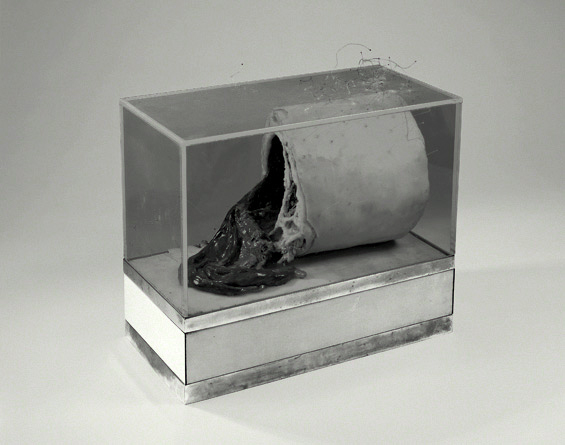
Paul Thek
In the Eighties, Paul Thek was called ‘one of the great failures in contemporary art.’ Now, a posthumous retrospective at the Whitney Museum of Art in New York seeks to change all that. Thek’s work ranges from casts of various body parts to ethereal paintings of gnomes, dinosaurs, mushrooms and other fits of ’60s and ’70s psychedelia. While considered an artist’s artist today, Thek made quite a few friends throughout his brief career, which spanned from the mid-60s until his death in the late 80s. Photographs by his lover, the late Peter Hujar, are included in the show. So is a painting he made for Susan Sontag, who dedicated Against Interpretation and AIDS and its Metaphors to him.
Thek scandalized the 1960s New York art world with his wax ‘meat sculptures’, which included a birthday cake made from tiers of chest. Andy Warhol collaborated with the artist, popping a meat slab into one of his Brillo boxes. ‘It delighted me that bodies could be used to decorate a room,’ Thek wrote, ‘like flowers.’ While austere minimal objects where de rigueur, he felt these oozing severed hands and hairy cross-sections were ‘emotional’ or just plain hot in a way that minimalist art was not.

It’s great to see Thek finally earning a Whitney show, but you still really need to read between the lines. His gayness is all but written over in wall texts that reduce him to mysticism: ‘as an artist… isolated, physical, delving beneath the surface towards the unknown.’ It’s important to engage his queerness head-on, particularly after the Smithsonian Museum’s recent censorship of David Wojnarowicz’s ‘A Fire In My Belly’, taking up the cultural issues alongside its aesthetics. Thek’s work is exciting, sexy and odd, but more touching, humane and ultimately more specific than the Whitney’s statements allow.
Writer Gary Indiana recently likened Thek to avant-garde visionary and filmmaker Jack Smith. ‘Thek knew we were here today, gone tomorrow, and that he was here to do the particular thing he did, whether the world valued what he was doing or not.’ Later in life (as in the show) Thek began making small, childlike canvases in vibrant colors. They’re campy little paintings that attacked the ’80s art world boom, which lauded big-boy painters like Julian Schnabel and Ashley Bickerton. The paintings are surprising because they’re so fun; the small work is totally subversive since it’s quirky and tacky, going against everything cherished by the taste of the (Reaganite) time and hetero society, at large. They span the last decade of his life, as his health waned. Thek died of AIDS related complications in 1988. For all their enthusiasm, as with this show, they’re like grinning through gritted teeth.